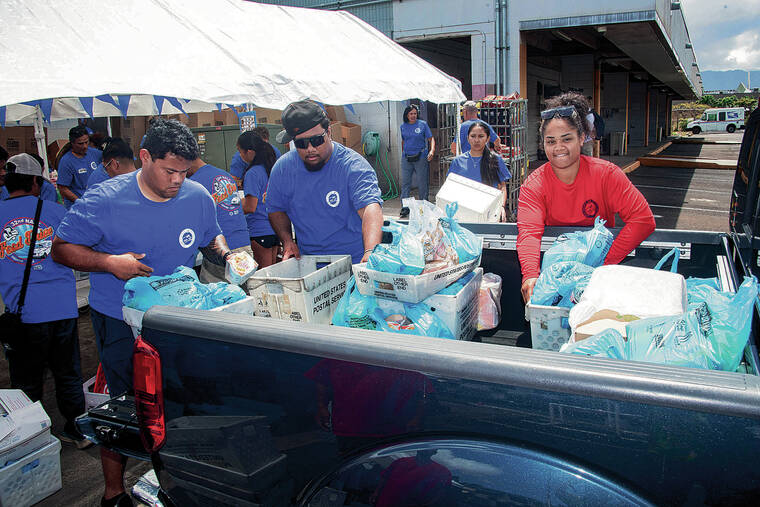Nearly one in three households in the state experienced food insecurity last year, and 29% of households with children had at least one child facing food insecurity, according to the Hawaii Food Bank’s 2023 report released Wednesday.
The U.S. Department of Agriculture announced earlier this year that Hawaii children could receive $177 in summer electronic benefit transfer funds through the federal SUN Bucks food benefit program, compared to $120 per eligible child on the mainland this summer.
SUN Bucks will provide $2.5 billion worth of groceries to an estimated 21 million children nationwide.
“Hawaii is in this together and we expect it will bring in between $12 million and $18 million to the state,” said Amy Miller, president and CEO of the Hawaii Food Bank.
Miller is concerned about young people facing food insecurity because it can lead to physical, cognitive and developmental disabilities, and can result in poor academic performance.
“Of food insecure households, 29 percent have children experiencing food insecurity,” Miller said, “and 6 percent of children go an entire day without food because they don’t have enough money for food.”
Additionally, 38% of adults in these households also face food insecurity.
“What often happens here is adults are forgoing food in order to feed their children,” Miller explained. “To us as parents, this may make sense, but the result is that almost 40 percent of parents and guardians of children under the age of 18 in Hawaii are food insecure.”
A statewide survey of 910 residents found that 11 percent of food-insecure households were classified as having low food security, characterized by poor dietary quality.
Additionally, 19% were classified as having very low food security, with poor eating habits due to being unable to afford food.
“We live in one of the richest countries in the world, and yet right now, the story isn’t that our communities don’t have enough food,” Miller says. “In fact, we have a food waste problem. The problem is that this efficient, healthy food is not available to many people because they can’t afford it.”
Miller argued that Hawaii’s high rates of food insecurity are due to inflation and low wages.
According to the Bureau of Labor Statistics, food prices in Hawaii have increased an average of 25 percent over the past three years.
“We also know that food insecure people tend to choose the cheaper, less healthy foods they can afford,” Miller said.
She said food insecurity is linked to chronic diseases such as hypertension, diabetes, coronary artery disease and arthritis.
Food insecurity translates into approximately $1,800 in additional health care costs per person per year.
Hawaii has a 30% food insecurity rate and costs an additional $800 million per year in food insecurity-related medical costs.
“I’m not a doctor, but I think it’s safe to say this is a public health crisis,” Miller said. “If we don’t do something about it today, we’re going to continue to pay these costs.”
Mayor Rick Blangiardi, a television executive who has been involved with food banks for more than 15 years, told the Honolulu Star-Advertiser that the numbers projected in the report are “alarming.”
“Sacrificing yourself, even risking chronic illness, so that your family and your children can have food to eat is something so primal and fundamental,” Blangiardi said.
He said he would like to look more closely at the issue of food insecurity to determine how Honolulu County can better support the community.
“The county hasn’t contributed much, so we’d like to know more about that so we can help,” Blangiardi said. “Right now we don’t know enough about it.”
The USDA Gus Schumacher Nutrition Incentive Program has provided federal grant funding to support SNAP Nutrition Incentive projects for the past 10 years. Each GusNIP project must secure non-federal matching funds equal to 100% of the federal grant funding.
Between 2018 and 2024, the state of Hawaii received $594,000 for these programs.
One of the financial incentives used in Hawaii’s SNAP Nutrition Incentive Program is the DA BUX Double Up Food Bucks program.
The statewide initiative, launched in partnership with Food Basket and the Hawaii Good Food Alliance, partners with grocery stores and food hubs to offer locally grown fruits and vegetables at a 50% discount.
Food Basket rebates discounts to retailers, increasing sales of locally grown produce to low-income households and increasing purchases by retailers from local farmers.
In November 2023, Gov. Josh Green awarded $500,000 to the DA BUX program.
Miller said he hopes the program will continue to receive support from the state through additional funding.
She said the state is also looking at other programs, such as a “farm-to-food bank” project that would allow food banks to buy food directly from local farmers and distribute it to communities.
“This is a win-win project,” Miller said. “Every dollar does two things: it invests in local agriculture and provides healthy, fresh produce to the people we serve.”


